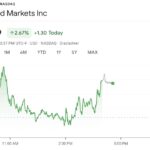The world of cryptocurrency is buzzing as Bitcoin has soared back to the impressive mark of $98,000. This exciting leap comes just as the Federal Reserve has decided to keep interest rates steady, a move that has garnered significant attention amidst ongoing economic discussions. Adding to the drama, former President Donald Trump has made headlines with his calls for a different financial approach.
With Bitcoin’s rapid ascent, many investors are keenly watching market trends, anticipating the implications for the broader economy. The decision by the Fed to hold rates steady is seen as a stabilizing factor in an ever-changing financial landscape. Traders and enthusiasts alike are optimistic about what this means for the future of cryptocurrency.
Amidst political commentary and economic strategies, Bitcoin’s resurgence is a focal point for many, signaling not just a recovery, but potentially a new chapter in digital currency’s evolution.
As the news unfolds, it’s clear that the interplay between traditional finance and the vibrant world of cryptocurrencies will continue to shape investor sentiment and market dynamics in the months to come.

Bitcoin Reaches $98K Amid Federal Reserve Rate Decisions
The recent surge in Bitcoin’s value to $98,000 has significant implications for investors and the broader economic landscape:
- Bitcoin’s Surge to $98K:
- Reflects increased demand and market confidence in cryptocurrencies.
- Highlights Bitcoin’s volatility and potential for substantial gains.
- Federal Reserve’s Steady Rate Policy:
- Maintaining interest rates can encourage investment in riskier assets like Bitcoin.
- A stable rate environment may lead to inflation concerns, driving more people to cryptocurrencies as a hedge.
- Impact of Political Climate:
- Political demands, such as Trump’s, can affect market sentiments and regulatory frameworks around cryptocurrencies.
- Political stability tends to bolster investor confidence, impacting Bitcoin’s price movements.
- Implications for Investors:
- Investors must navigate the interplay between economic indicators and market trends.
- Understanding these dynamics can lead to informed investment strategies and risk management.
In summary, Bitcoin’s rise and the Federal Reserve’s monetary policy present both opportunities and risks for investors, highlighting the need for awareness of market and political influences.
Bitcoin Surges to $98K: The Impact of Steady Fed Rates Amid Political Pressure
The recent spike in Bitcoin’s value, hitting the remarkable $98,000 mark, has captured the attention of both cryptocurrency enthusiasts and traditional investors alike. This rally comes in the backdrop of the Federal Reserve’s decision to maintain steady interest rates, even amidst pressure from political figures like Donald Trump who have voiced their opinions on economic policies. The juxtaposition of regulatory stability and market speculation provides an intriguing narrative within the ever-evolving cryptocurrency landscape.
One significant competitive advantage for Bitcoin in this scenario is the increased investor confidence stemming from regulatory stability. As the Fed keeps rates unchanged, it signals a cautious approach to monetary policy, allowing digital assets to flourish without the fear of immediate tightening that typically accompanies rising interest rates. This creates a favorable environment for Bitcoin as a store of value, attracting not only retail investors but institutional ones as well, who are increasingly looking toward cryptocurrencies as a hedge against inflation.
However, this upswing is not without its complications. The very political pressures mentioned earlier may introduce volatility into the market. Political statements can lead to erratic price swings, depending on how investors perceive the implications of such demands. This unpredictability could deter more risk-averse investors from fully committing to Bitcoin, especially those who prefer a more stable and regulated asset class.
The news surrounding Bitcoin’s rise could benefit a wide range of stakeholders. For instance, emerging investors seeking high-yield opportunities are likely to be drawn to this bullish trend, while existing holders may find renewed affirmation in their investment strategies. Moreover, crypto exchanges and platforms stand to gain significantly from increased trading activity as the buzz surrounding Bitcoin draws in new users eager to capitalize on potential gains.
On the flip side, traditional financial institutions that often critique the volatility of cryptocurrencies might face challenges as Bitcoin’s mainstream acceptance continues to climb. Established banks and investment firms could find themselves competing in a landscape where digital currencies are no longer an afterthought but a serious contender. Moreover, if prices continue to sway dramatically due to political influences, it may prompt further skepticism from regulators, potentially leading to more stringent oversight.
In summary, while Bitcoin’s ascent to $98,000 amid steady interest rates presents clear opportunities for a variety of market participants, it also unfurls a web of complexities driven by political engagement and market volatility. The balance between harnessing Bitcoin’s potential and navigating its risks will be key for investors and institutions alike in the coming months.

















